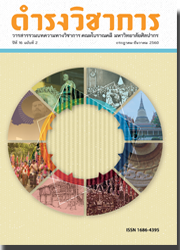Variations on Residential Architecture in Relation to Economic Factors :A Case Study of Ban Pla Khao, Tambon Pla Kh
Keywords:
Lifestyle, Architecture, Principle, Belief, GlobalizationAbstract
This article looks at the lifestyle and the residential architecture of Ban Pla Khao community in Amnat Charoen province in the past two decades (around 2540-2560 BE) in which Thailand has diversified domestically, socially, and politically while the world’s economies have changed simultaneously. Changes to communications technology including data transmission (IT Globalization) have made it easier for people to learn and transfer data without boundaries.
It was found that economic factors are obviously an important influence on the Ban Pla Khao community’s lifestyle including changes to their careers. Primarily, the Ban Pla Khao community comprised of agriculturists and farmers. Over time more and more of them have left the agricultural sector, heading towards the capital city or other big cities. Most of the younger generation have abandoned agricultural work and now do other things for a living instead, owing to low agricultural commodity prices and natural disasters. Therefore the Ban Pla Khao people have had to earn money from other kinds of work to be able to sufficiently support their families and way of life.
In addition, economic factors have affected the residential architecture both directly and indirectly by causing changes to areas such as residential design, construction materials, and internal residential areas. Lots of changes in several aspects in the Ban Pla Khao community and other northeastern localities have affected the long-inherited principles, beliefs, customs, traditions, and cultures substantially.
References
ธิติญา เหล่าอัน, 2554. ความเปลี่ยนแปลงทางเศรษฐกิจของ “สังคมชาวนา” อีสาน ตั้งแต่ พ.ศ.2500-2550 ศึกษากรณีหมู่บ้านกู่กาสิงห์ จังหวัดร้อยเอ็ด. สงขลา: มหาวิทยาลัยทักษิณ.
นภาพร อติวานิชยพงศ์, 2557. “คนชนบทอีสานกับการทำมาหากิน: ความเปลี่ยนแปลงตามยุคสมัย. กรุงเทพฯ: มหาวิทยาลัยธรรมศาสตร์.
เบญจวรรณ นาราสัจจ์, 2552. ประวัติศาสตร์ภูมิปัญญาอีสาน. ขอนแก่น: มหาวิทยาลัยขอนแก่น.
ปก แก้วกาญจน์, 2530. “ความเคลื่อนเปลี่ยนเกี่ยวกับวิถีชีวิตชุมชนชาวนา จากผลกระทบของการผลิตเพื่อขาย ในช่วง 2 ทศวรรษ (ศึกษากรณีบ้านเขาเจียก อำเภอเมือง จังหวัดพัทลุง). รายงานวิจัยสถาบันทักษิณคดีศึกษา มหาวิทยาลัยศรีนครินทรวิโรฒ.
ปรุงศรี วัลลิโภดม และคนอื่น, 2542. วัฒนธรรม พัฒนาการทางประวัติศาสตร์ เอกลักษณ์และภูมิปัญญา จังหวัดอำนาจเจริญ . กรุงเทพฯ: 2530.
วิโรฒ ศรีสุโร, 2530. “สมถะสถาปัตยกรรม.”สถาปัตยกรรมอีสาน. สัมมนาทางวิชาการ “เอกลักษณ์สถาปัตยกรรมอีสาน”
ศรีศักร วัลลิโภดม, 2552. เรือนไทย บ้านไทย. กรุงเทพฯ: เมืองโบราณ.
สมชาย นิลอาธิ, ราชันย์ นิลวรรณาภา, ณรงค์ศักดิ์ ราวะรินทร์, 2555. เฮือนพื้นถิ่น: วิถีชีวิตและคติความเชื่อในใบลาน. มหาสารคาม: มหาวิทยาลัยมหาสารคาม.
สมชาย ภคภาสน์วิวัฒน์, 2555. ระเบียบโลกใหม่ NEW WORLD ORDER. กรุงเทพฯ: อมรินทร์พริ้นติ้งฯ.
อภิศักดิ์ โสมอินทร์, 2525. ภูมิศาสตร์อีสาน. กรุงเทพฯ: พรศักดิ์แอนด์แอสโซซิเอท.
Downloads
Published
Issue
Section
License
บทความนี้เป็นผลงานของข้าพเจ้าแต่เพียงผู้เดียว และ/หรือเป็นผลงานของข้าพเจ้าและผู้ร่วมงาน ตามชื่อที่ระบุในบทความจริง และเป็นผลงานที่มิได้ถูกนำเสนอหรือตีพิมพ์ที่ใดมาก่อน




